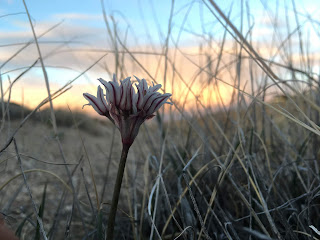Corydalis shanginii ssp. ainii with Aquilegia saximontana behind.
If you were curious, as one may never see a Manzanita (Arctostaphylos) seedling in real life, this is what one looks like before it dies.
To date, I've got one living plant grown from seed.
The stickleaf family has christmas-tree shaped velcro hairs. Look'em up.
Townsendia cf. incana . North of Grand Junction, Colorado.
Allium macropetalum is often the first thing to bloom in March after the very first flowers here: humble desert parsleys.
Tulipa linifolia. Good cheese for the rock garden.
Linum cariense or aretiodes. I get so focused on planting the really important stuff I forget to record the name. Anyone able to help me out?
In leaf.
A Buckthorn for the crevice garden. Because it's a natural limestone crevice dweller in the wild in Southern Europe. Rhamnus pumila. Just soak up that bright green skittle.
Sunscapes has sold it the last few years. They are dioecious: plants are either boys or girls. Potted plants seemed to get infected with a root fungus that would hang with them for a while and then murder them. I'll keep killing 5 at a time to get one of them to stay for posterity. They creep over rocks with their amazing gnarled tiny tree trunks. Self-bonsai. I realized a great use for this plant (in some public gardens I was working in) is where you need a good green in a place that is terribly exposed in winter. No problem- this guy (or gal) is deciduous and opts out of having to deal with winter.
Lepidium nanum, R.I.P.
Let this be a lesson. If you've proudly not watered a garden for five years, but this year is a dangerously dry year, water your damn garden (Just once, even!) to save your plants.
'Firespinner' at Montrose Botanic
A hyrbid Sax at Dom's in Colorado Springs.
Erigeron compactus might be my new favorite Fleabane.
No. It is.
Leptodactylon watsonii.
Largest one I've seen in this state.
Scutellaria orientalis. It grows on road-cuts all over Asia, and in the garden blooms for so long you forget how long it does. A bajillion forms and subspecies, this might be var. pinnatifida or a garden hybrid thereof. Easy from cuttings.
Junellia succulentifolia, Agave parryi, Onosma sp.
Penstemon eatonii/barbatus hybrid?
Cornus kousa in a friend's garden. North Side of a house.
Castilleja scabrida is most apt to succeed in a trough- here at Betty Ford Alpine Gardens.
Gentiana dahurica. My godsend.
I've killed every alpine Gentian I've ever tried here in the semi-desert. I plant them, crying. Again. And again. I had one bloom. Once. With one flower. And then it died. I think 105 F (41C) is just too hot no matter how much you water. Finally- a part sun/ dry shade
Gentiana. I don't care if the flowers aren't those tuba-sized
G. acaulis you all can grow. It's true blue; look at it compared to other bastard blues on the right. They grow flats of this living sapphire at the local
Valley Grown Nursery and no one buys it. I saw it naturalizing in grass under aspen in a mountain town in Colorado recently- the summers get dry up there, even. This is the one, beloved. Get you some.
Erigeron vagus in the Maroon Bells of Colorado.
A good mountain bike crash and hitting my head gave me the revelation for my first plant breeding. Behold, the dragonlemon.



























































